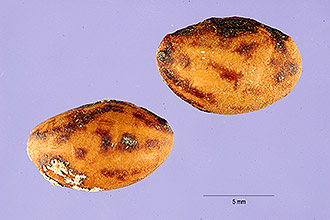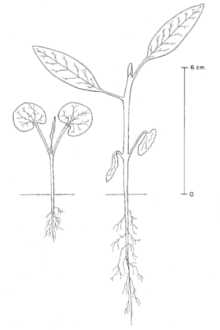Indian Plum
Scientific Name: Oemleria cerasiformis (Torr. & A. Gray ex Hook. & Arn.) Landon

| General Information | |
|---|---|
| Usda Symbol | OECE |
| Group | Dicot |
| Life Cycle | Perennial |
| Growth Habits | ShrubTree, |
| Native Locations | OECE |
Plant Guide
Use soil moisture sensors to measure the soil moisture of Indian Plum.
Fact Sheet
Alternate Names
Oemleria cerasiformis is named for Augustus Gottlieb Oemler (1773-1852), a German-American pharmacist and naturalist. Previous scientific names include Nuttallia cerasiformis Torr. & A. Gray ex Hook. & Arn. and Osmaronia cerasiformis (Torr. & A. Gray ex Hook. & Arn.) Greene. Osoberry is a frequently used common name while Oregon plum, Indian peach, and bird cherry are also synonyms.
Uses
Often the first deciduous native shrub to flower in late winter, Indian plum is an important early season nectar source for hummingbirds, moths and butterflies, native bees and other pollinator species. Indian plum is popular for Pacific Northwest restoration projects due to its ease of propagation, rapid growth, and wide tolerances for various shade and moisture regimes. The fibrous roots resist erosion. Clones that root more readily can be employed in restoration projects as live stakes or as rooted cuttings. With adequate sunlight, it bears numerous late winter/early spring flowers from a young age but root sprouting may limit its landscape use to larger settings. Various small mammals plus foxes, coyotes, deer, bears, and many bird species consume the ‘plums’ and disperse the seed. For livestock, this species is considered unpalatable. Indian plum fruit is edible for humans but is often bitter, even when fully ripe. Native Americans ate the fruit fresh, dried, or cooked. The bark was used as a tuberculosis remedy and a mild laxative. Strips of bark were used to bind harpoon tips.
Status
Please consult the PLANTS Web site and your State Department of Natural Resources for this plant’s current status (e.g. threatened or endangered species, state noxious status, and wetland indicator values).
Description
Indian plum is a fast growing but relatively short-lived perennial deciduous shrub or small tree of 6 to 16 feet, Use soil moisture sensors to measure the soil moisture of Indian Plum., It is the only species of its genera and the only member of the Prunoid subfamily of Rosaceae that is usually dioecious (separate male and female plants) or produces more than one fruit per female flower, Indian plum is native and common at lower elevations from extreme southwest British Columbia to Oregon’s Willamette Valley and surrounding foothills, Continuing south, it becomes less common in the California Coast Ranges to Santa Barbara County and western slopes of the Sierra Nevada Mountains to Tulare County California, For current distribution, please consult the Plant Profile page for this species on the PLANTS Web site, Fragrant 1/2 inch greenish white flowers usually appear by late winter in loose hanging clusters of 10 to 20 flowers each, Leaves also emerge early taking advantage of sunlight before overstory trees produce leaves and shade, Indian plum leaves are alternate, lance-shaped and 2 to 5 in, long, with smooth edges that are rolled under somewhat, The leaves are pale green, paler below and give off a cucumber-like odor when crushed, They begin turning yellow in mid summer, Twigs are smooth and purplish brown with noticeable orange pores (lenticels), Partitions inside the pith (center of the stem) create small chambers that are visible when the twig is split lengthwise, The bark has a bitter taste, The 1/2 inch fruit of Indian plum, numbering up to 5 per flower, start out tan to pale orange, transition through pink to reddish purple, then ripens bluish black with a thin waxy coat, The seed is a stone, or pit, that contains cyanoglucosides (the bitter, toxic compounds also found in almonds), © PROVINCE OF BRITISH COULMBIA Indian plum occurs primarily below 1000 feet elevation but up to 5000 ft, in the southern part of its range, It is often found in moist open forests, clearings, riparian areas, along roadsides and fence lines, on hillsides and in canyons, It also occupies drier forests, chaparral and coastal scrub habitats, Indian plum grows on most soil textures but not on sites that are saturated in winter or especially shady,
Establishment
Indian plum seed is easily gathered by hand-stripping fruit in May to July depending on location. Ten pounds of fresh fruit will yield approximately 2.5 lb. of seed. Macerate the fruit in a blender and rinse the seed over a screen to remove the pulp prior to storage under cool (33-38 degrees F) and dry conditions. Seeds of Indian plum are larger toward the southern extent of its range with about 1800 seeds per pound in California versus more than 4000 in Washington. Viability is usually high with 90+% germination after two to four months of moist chilling (stratification). Bottom heat may aid germination, which will occur in about a week. Although Indian plum is usually propagated by seed, dormant season digging of root suckers or seedlings, layering, and cuttings can also be effective. Hardwood cuttings of vigorous 1-yr old wood collected early in winter and treated with rooting hormone often perform well. Success with softwood and semi-hard wood cuttings has also been reported. New plants can be obtained by layering in the spring with separation from the parent plants during the following dormant season.
Management
Indian plum is shallow rooted and will benefit from occasional irrigation during the first year or two of establishment. For riparian conservation sites, plant Indian plum 4-6 feet apart in the overbank or transition zones. Greater spacing is recommended for landscape specimens. Older shoots and suckers may be removed or limbs pruned back to reduce overall size. Established plants may be cut back to near the crown in winter for complete rejuvenation.
Pests and Potential Problems
Indian plum rarely suffers insect or disease injury but can be susceptible to rhododendron lace bug (Stephanitis rhododendri) and a conidia producing leaf spot fungus, Cylindrosporium nuttallii. Indian plum may display chlorosis (leaf yellowing) on shallow soils overlying chalk.
Plant Traits
Growth Requirements
| Temperature, Minimum (°F) | 28 |
|---|---|
| Adapted to Coarse Textured Soils | No |
| Adapted to Fine Textured Soils | No |
| Adapted to Medium Textured Soils | No |
| Anaerobic Tolerance | Medium |
| Cold Stratification Required | Yes |
| Drought Tolerance | Low |
| Frost Free Days, Minimum | 207 |
| pH, Maximum | 7.2 |
| pH, Minimum | 5.0 |
| Planting Density per Acre, Maxim | 2560 |
| Planting Density per Acre, Minim | 1280 |
| Precipitation, Maximum | 33 |
| Precipitation, Minimum | 16 |
| Salinity Tolerance | Low |
| Shade Tolerance | Intermediate |
Morphology/Physiology
| Coppice Potential | No |
|---|---|
| Shape and Orientation | Erect |
| Resprout Ability | No |
| Nitrogen Fixation | None |
| Lifespan | Short |
| Low Growing Grass | No |
| Bloat | None |
| Fall Conspicuous | Yes |
| Fire Resistant | No |
| Flower Color | White |
| Flower Conspicuous | Yes |
| Foliage Color | Green |
| Foliage Porosity Summer | Dense |
| Foliage Porosity Winter | Porous |
| Foliage Texture | Medium |
| Fruit/Seed Color | Purple |
| Fruit/Seed Conspicuous | Yes |
| Growth Form | Multiple Stem |
| Growth Rate | Rapid |
| Height at 20 Years, Maximum (fee | 20 |
| Height, Mature (feet) | 5.0 |
| Known Allelopath | No |
| Leaf Retention | No |
Reproduction
| Small Grain | No |
|---|---|
| Seed Spread Rate | Rapid |
| Seed per Pound | 3215 |
| Propagated by Bulb | No |
| Propagated by Tubers | No |
| Propagated by Sprigs | No |
| Propagated by Sod | No |
| Propagated by Cuttings | Yes |
| Propagated by Corm | No |
| Propagated by Container | Yes |
| Propagated by Bare Root | Yes |
| Fruit/Seed Persistence | No |
| Bloom Period | Spring |
| Propagated by Seed | Yes |
Suitability/Use
| Veneer Product | No |
|---|---|
| Pulpwood Product | No |
| Post Product | No |
| Palatable Human | Yes |
| Palatable Browse Animal | Low |
| Nursery Stock Product | Yes |
| Naval Store Product | No |
| Lumber Product | No |
| Fodder Product | No |
| Christmas Tree Product | No |
| Berry/Nut/Seed Product | No |


